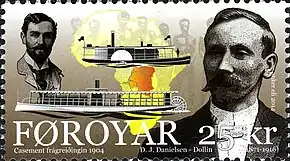Daniel Jacob Danielsen (also known as Dollin, born 25 June 1871 in Copenhagen,[1] died in Tórshavn 16 October 1916) was a Faroese missionary and humanitarian worker.[2]
Family and early years
Danielsen's mother Sigrid was a paternal aunt of Victor Danielsen, who was the first Faroese Bible translator and Open Brethren missionary. Sigrid went to Copenhagen as a young girl. In 1871 she gave birth to a boy; she was not married at the time. The boy was named Ludvig Daniel Jacob. The name Ludvig was after his father, whom he never knew, and he did not use the name. Dollin is a common abbreviation for Daniel Jacob in the Faroe Islands. Fairly soon after the birth of D.J. Danielsen, mother and son moved back to the Faroes, where she got married in 1874.
At the age of 18 Danielsen went to Scotland to be trained as an engineer. He worked as an engineer around the world; among other countries he came to South Africa and to America. Even though he came from a Christian family, it was not until 1897 that he became religious; it happened at an open-air service in Glasgow, after which he was radically converted.[1]
Missionary and humanitarian work
From 1901 to 1903, Danielsen was in the Congo Free State as a missionary for the Congo-Balolo Mission, primarily based in Bonginda. He mainly worked as an engineer on the missionary boat that sailed up and down the Congo River, occasionally working as a missionary himself.[3]

Following accusations of using corporal punishment against the natives, he was recalled from the mission in 1903. On his way back to the shore, he met then-British Consul in the Congo Roger Casement. Casement had been anointed to write a report on the atrocities enacted against the natives by Belgian soldiers. Then a personal property of King Leopold II of Belgium, the local Congolese population was being used for forced labour in the rubber industry, and stories of their abuse soon caught the attention of the British press. The locals were coerced into the rubber trade through a variety of violent methods: these included whipping, hostage-taking, rape, murder, amputation of limbs, as well as the immolation of gardens and villages. In desperate need of an engineer to steer his boat, Casement hired Danielsen on 17 July. Alongside his duties as engineer, Danielsen also acted as Casement's interpreter, translator and principal photographer, being the man responsible for photographing the report's most prominent atrocities. Following the report's conclusion, he exhibited the photographs in meetings in England and the Faroe Islands.[4]
In 1904 Danielsen moved to the Faroe Islands with his wife, Lina, where he became one of the most prolific evangelists for the Brethren movement in the Faroes.[3]
References
- 1 2 Jacobsen, Óli. "Daniel J. Danielsen (1871–1916): The Faeroese who Changed History in the Congo". Brethrenhistory.org. Retrieved 27 December 2015.
- ↑ Maye, Brian (14 December 2014). "Daniel J Danielsen – a pioneering humanitarian who helped Roger Casement expose the horror of Belgian rule in the Congo". The Irish Times. Retrieved 27 December 2015.
- 1 2 Jacobsen, Óli (2014). Daniel J. Danielsen and the Congo: Missionary Campaigns and Atrocity Photographs (PDF). Brethren Archivists and Historians Network. ISBN 978-0-9570177-4-0.
- ↑ Petersen, Anker Eli (24 September 2014). "The Casement Report 1904 and Daniel J. Danielsen". Stamps.fo. Retrieved 27 December 2015.